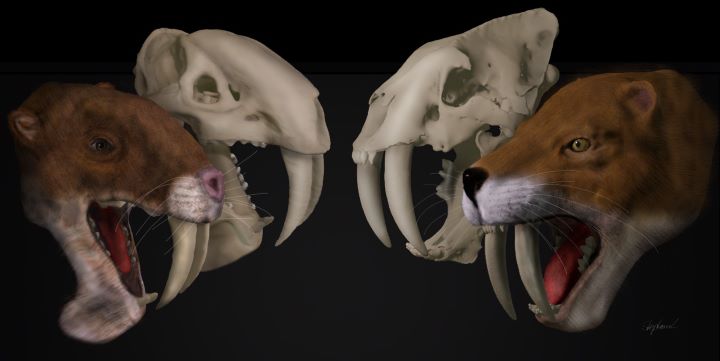
Not all sabretooth cats were fearsome predators – some may have been scavengers using their teeth to rip open carcasses before extracting their prey’s innards with a big tongue, according to a new study.
Thylacosmilus atrox lived some five million years ago in Argentina – a jaguar-sized marsupial with huge canines, fuelling speculation it was an even more vicious predator than placental carnivores, such as the North American Smilodon fatalis, that it superficially resembled.
Popularly known as the ‘marsupial sabretooth’, Thylacosmilus may not have been a fierce predator like the extinct placental sabretooths, which seem to have been much like modern cats but with a different mode of killing their prey.
An international team of researchers from the Universities of Birmingham and Bristol, in the UK, and Vanderbilt University, in the USA, performed a series of studies on the skull and teeth of Thylacosmilus and have published their findings in Peerj.
A statistical study, comparing aspects of the skull and teeth of Thylacosmilus with both present-day big cats and a diversity of extinct sabre-toothed cats, confirmed suspicions about the differences from its placental supposed counterparts.
Dr Stephan Lautenschlager, from the University of Birmingham, commented: “We found there was a difference in behaviour between the two species: Thylacosmilus’ skull and canines are weaker in a stabbing action than those of Smilodon but stronger in a ‘pull-back’ type of action.
“This suggests Thylacosmilus was not using its canines to kill with, but to open carcasses. We suspect it was some sort of specialised scavenger, using those canines to open carcasses and perhaps using a big tongue to help extract the innards.”
Researchers discovered the canines of Thylacosmilus were different from the teeth of other sabre-toothed mammals, being triangular in shape like a claw rather than flat like a blade.
Dr Christine Janis, from the University of Bristol, commented: “The animal has impressive canines, but if you look at the whole picture of its anatomy, lots of things simply don’t add up. It lacks incisors, which big cats today use to get meat off the bone, and its lower jaws were not fused together.”
Besides the puzzling lack of incisors, researchers found that Thylacosmilus’ molars were small and not worn along the sides as seen in an animal feeding on meat.
“The molars tend to wear flat from the top, rather like you see in a bone crusher. But if you examine the detailed microwear on tooth surfaces, it’s clear that it was eating soft food. Its wear is most similar to that of cheetahs which eat from fresh carcasses and suggests an even softer diet than fed to captive lions. Thylacosmilus was not a bone-crusher and may have instead specialized on internal organs,” explained Dr Larisa DeSantis, from Vanderbilt University (USA).
Sabretooths are among the most iconic fossil animals with a reputation for being fierce predators - but these animals came in all shapes and sizes and nearly 100 different species are known to science so far.
“The skull superficially looks rather like that of a sabre-toothed placental, but if you actually quantify things, it becomes clear that Thylacosmilus’ skull was different in many details from any known carnivorous mammal, past or present,” commented Dr Borja Figueirido, from the University of Málaga (Spain).
Researchers are clear that Thylacosmilus was not just a marsupial version of a saber-toothed cat like Smilodon. They found that, in addition to differences in skull and teeth, it was also short-legged and stiff-backed, and lacked retractile claws, so it would have had difficulties in pursuing its prey, pouncing on it and holding on to it.:
- For more information, please contact Tony Moran, International Communications Manager, University of Birmingham on +44 (0)782 783 2312. Out-of-hours, +44 (0) 7789 921 165. The University of Birmingham is ranked amongst the world’s top 100 institutions, its work brings people from across the world to Birmingham, including researchers and teachers and more than 6,500 international students from over 150 countries.
- ‘An eye for a tooth: Thylacosmilus was not a marsupial ``saber-tooth predator' - Christine Janis, Borja Figueirido, Larisa DeSantis and Stephan Lautenschlager is published in Peerj.